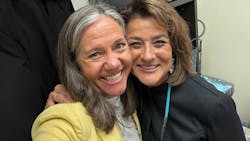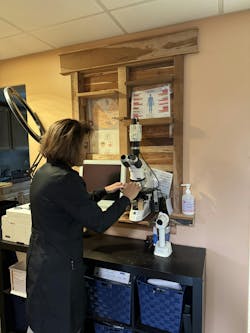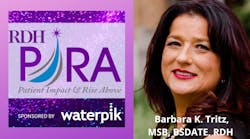My visit to biological hygienist, Barbara Tritz
What you'll learn in this article
- Biological dental hygiene focuses on whole-body health to prevent and heal dental diseases naturally.
- Ozone therapy reduces sensitivity, kills harmful pathogens, and promotes healing without harsh chemicals or discomfort.
- Phase contrast microscopy reveals real-time plaque activity, guiding personalized, science-based oral health interventions.
- Low pH and nitric oxide levels can impact oral and cardiovascular health—nutritional changes help improve both.
- Home care tools like ozone oil, probiotics, and erythritol polishing significantly enhance gum and tooth health.
Editor’s note: Read Barbara’s recent RDH article about biological dental hygiene to learn more about what is involved in this holistic approach to dental care.
I’ve been following Barbara Tritz, the Queen of Dental Hygiene, for a few years now. When a speaking event took me to Seattle, I knew it was a perfect opportunity to see for myself what it means to be a biological dental hygienist. (As stated by Barbara in her RDH article, the mission of a biological hygienist, “… is to look within the body to help patients prevent and heal their dental diseases.”)
I arrived early on a Tuesday morning at Barbara’s practice, Green City Dental in Edmonds, Washington. I beat her to the office, so I had the opportunity to watch her set up for the day. After turning off the alarm, Barbara got the Ozone bubbler going so there would be fresh ozone water and gas ready for me. After a tour of the office and when the ozone water was ready and in the unit water bottle, we got to work.
What happened during my biological dental visit
The first thing Barbara did was take my blood pressure and blood oxygen levels. Then, using strips, she evaluated my pH and nitric oxide levels. Both of mine were low. Barbara and I discussed how low pH can increase the risk for caries and periodontal disease, and that my low nitric oxide could adversely affect my blood pressure (which was a little high, but I chalked that up to being excited about the visit). Ways to increase my nitric oxide levels include eating dark leafy greens and nitric oxide gummies.
Then Barbara did the thing I was most looking forward to: she took a plaque sample from all four quadrants of my mouth and prepared the slide for the phase contrast microscope. I was hoping she’d say I had no plaque, but after 45 years, Barbara knows where to look. The slide would be ready for viewing at the end of the appointment.
She then asked if I had any sensitive spots in my mouth. I told her about the recession I have on no. 19 F and how sometimes it feels “zingy.” I rated it 4 out of 10 on the pain scale. Barbara said ozone gas can eliminate the sensitivity. She popped in the Optragate and held the oxygen-ozone gas over no. 19 F for about two minutes.
After some water and a puff of air, I didn’t feel any sensitivity! Then she applied the ozone gas under the gumline to eliminate the pathogens in the biofilm in the rest of my mouth. It felt pleasant and relaxing as she slowly made her way around.
Then she did a thorough medical history review, intra- and extraoral cancer screening, airway assessment, and periodontal exam. I have current x-rays on file, so we skipped those.
Next came the disclosing solution to find the biofilm. I’m pleased to report I didn’t have too much. Phew! All that extra home care prior to the appointment paid off. Then Barbara grabbed her air polisher loaded with erythritol powder and disrupted any remaining biofilm. She then moved on to her piezo and trusty hand instruments and went through my entire mouth, removing any deposits. It felt great when she popped off that spicule between nos. 24 and 25!
I had more bleeding than expected during the scaling, so Barbara went back with the ozone gas to eliminate the biofilm that was disrupted during the scaling process. Then she cleaned my tongue with a metal tongue scraper and applied hydroxyapatite varnish. Viola! My teeth felt great!
What the microscope revealed, and take-home tips
It was now time to check out the microbial activity in my plaque on the slide Barbara had prepared at the beginning of my appointment. She loaded it up in the phase contrast microscope and started scanning. We found healthy cocci and a few high-risk gliding rods. Barbara assured me that having a few of the high-risk guys was normal as long as the good guys were in the majority.
As she scanned further, she found one section with phagocytosis. She said I likely caused a small trauma while flossing before my appointment, and this was a healing response to my overzealous home care. Then she offered me a probiotic to finish off the appointment.
All in all, things were good, but that “little bit” of bleeding was a concern, right? I also have some airway work that needs to be addressed. Definitely a tongue tie release, and perhaps a palatal expansion. I have some great tori. But until I can get that addressed, Barbara gave me some recommendations to get started.
She suggested I get some ozone oil, dip in an interdental brush or rubber tip stimulator, and massage that into my gums, as well as get a boil and bite mouth guard, put it in the oil, and wear it while I shower. I asked about putting the oil in my current trays, but Barbara said she didn’t want the ozone oil to damage my trays and to use the boil and bite.
She also recommended that I consider purchasing a small ozone generator so that I could put that into my water flosser and irrigate my gums daily with active ozone. We also talked about supplements. She told me to check my fat-soluble vitamin levels (A, D, E, and K), consider supplementing where needed, and adding fish oil. She also recommended nitrite gummies to help increase those levels.
I can’t wait to get home, try some of these new home-care techniques, and see how they impact my oral and overall health! After my visit with Barbara Tritz, biological hygienist, I can totally see why she’s so passionate about dental hygiene and how she delivers care.
About the Author

Amanda Hill, BSDH, RDH, CDIPC
Amanda Hill, BSDH, RDH, CDIPC, is an enthusiastic speaker, innovative consultant, and award-winning author who brings more than 25 years of clinical dental hygiene and education to dentistry. Recipient of ADS’s Emerging Infection Control Leader award and an active participant with the advisory board for RDH magazine, DentistryIQ, and ADS’s Infection Control in Practice Editorial Review Board and membership committee, Amanda (also known as the Waterline Warrior) strives to make topics in dentistry accurate, accessible, and fun. She can be reached at [email protected].



